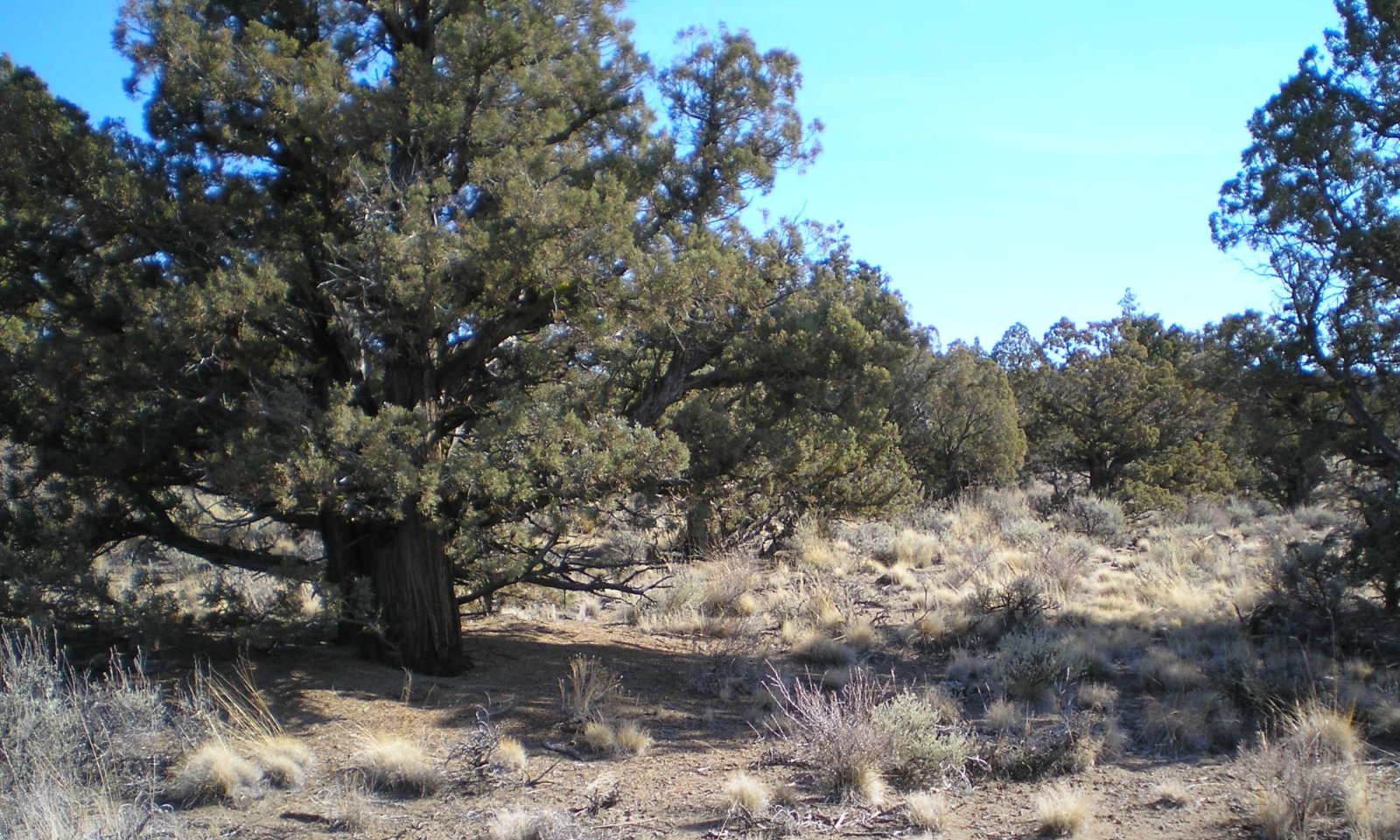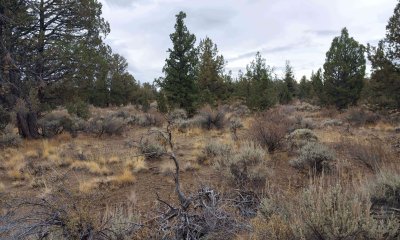
Juniper Shrubby Pumice Flat 10-12 PZ
Scenario model
Current ecosystem state
Select a state
Management practices/drivers
Select a transition or restoration pathway
-
Transition T1A
Non-native species, fire, heavy grazing, and/or increased CO2 levels.
More details -
Restoration pathway R2A
Mechanical treatment of infill trees (non-old growth juniper); non-native species are not present.
More details -
Transition T2A
Time.
More details -
Restoration pathway R3A
Mechanical treatment of infill trees (non-old growth juniper).
More details -
Transition T3A
Time or stand replacement fire.
More details -
No transition or restoration pathway between the selected states has been described
Target ecosystem state
Select a state
Description
The Reference state is representative of the natural range of variability under pristine conditions. No introduced species occur in this state and disturbance has not fundamentally altered soil quality or plant community composition. This state represents a persistent old growth juniper woodland and has two general plant communities; a grass – shrub dominant community and a grass – forb dominated community. Both support an open stand of old growth juniper.
Negative feedbacks enhance ecosystem resilience and contribute to the stability of the state. These include the presence of all structural and functional groups and low fine fuel loads. Plant community phase changes are primarily driven by climate. Warm, dry cycles resulting in severe drought stresses plants and increases susceptibility to insects and disease. Cooler, wetter cycles that are conducive to tree establishment may result in woodland infill, and fine fuel accumulations may result in single tree or small area fires. Fire return interval is centuries.
Characteristics and indicators
• Lack of introduced plant species • Presence of all functional and structural groups • High plant vigor and reproductive capacity in most years
Resilience management
Management should focus on preservation of old growth juniper and prevention of non-native species establishment. Removal of infill trees to maintain pre-European infill rates can prevent transition to State 2.
Submodel
Description
This state is similar to the reference state yet some amount of introduced species occur and/or infill rates are exceeding pre-European settlement rates. Ecological function is largely intact, however the resiliency of the state has been reduced. This state represents a persistent old growth juniper woodland and has two general plant communities; a grass – shrub dominant community and a grass – forb dominated community. Both support an open stand of old growth juniper. Non-natives may increase in abundance but will not become dominant within this State.
Negative feedbacks enhance ecosystem resilience and contribute to the stability of the state. These include the presence of all structural and functional groups and low fine fuel loads. Positive feedbacks decrease ecosystem resilience and stability of the state. These include the non-natives’ high seed output, persistent seed bank, rapid growth rate, residual dry matter accumulation, and adaptations for seed dispersal.
Plant community phase changes are primarily driven by climate. Warm, dry cycles resulting in severe drought stresses plants and increases susceptibility to insects and disease. Cooler, wetter cycles that are conducive to tree establishment may result in woodland infill, and fine fuel accumulations may result in single tree or small area fires. Fire return interval is centuries.
Characteristics and indicators
• Presence of all functional and structural groups • High plant vigor and reproductive capacity in most years
Resilience management
Management should focus on preservation of old growth juniper and prevention of non-native species expansion. Removal of infill trees to maintain pre-European infill rates can prevent transition to State 3; or restore to Reference (State 1) if non-native species are not present.
Submodel
Description
In this state western juniper dominates the overstory and site resources. Young juniper (<100 years old) is co-dominant with old growth juniper and increasing. Bitterbrush, big sagebrush, and perennial bunchgrasses may still be present, but they are no longer controlling site resources. Soil moisture, soil nutrients and soil organic matter distribution and cycling have been spatially and temporally altered.
Increased pace of tree recruitment results in a multi-age class overstory. As tree density increases, shrub mortality increases, and deep-rooted perennial grasses are reduced. Bare ground interspaces are large and connected, allowing for establishment and expansion of cheatgrass, annual forbs, mustards, and granite prickly phlox.
Characteristics and indicators
• Western juniper infill trees are co-dominant with old growth trees or dominant in the overstory • Presence of all functional and structural groups, though diversity may be reduced • Bare ground patches are large and connected
Resilience management
Management should focus on preservation of old growth juniper and promoting native understory vigor and expansion. Removal of infill trees to release resources and reduce competition for native understory vegetation can help maintain State 3; or restore to Current Potential (State 2) if all functional groups and understory species are present.
Submodel
Description
In this state, perennial bunchgrasses and non-resprouting shrubs are greatly reduced or missing on the site. The understory has been replaced by non-native annual grasses and forbs, sprouting shrubs, and native increasers. Competition with the tree overstory and/or repeated disturbances such as fire, heavy grazing, and recreational use has allowed non-resprouting shrubs and perennial grasses to be replaced by cheatgrass, an invasive annual grass, and introduced annual forbs like pale madwort (Alyssum alyssoides). Forbs (e.g. granite prickly phlox , Linanthus pungens and tansymustard, Descurainia sp.) and sprouting shrubs (e.g. rabbitbrush species) also increase and fill open spaces in the understory.
This state may still support a western juniper overstory. If the site has not had a stand replacement fire, it will be a mix of old growth and young juniper. Following a stand replacement fire, the tree overstory will be temporarily lost. Time without disturbance will allow trees to reestablish. However, fuel continuity typical of annual dominated systems causes fires to become more frequent and widespread making replacement of old growth trees unlikely. Reestablishment of old growth trees would take centuries without disturbance (primarily fire), and feasibility of this pathway is currently unknown.
Characteristics and indicators
• Understory is dominated by cheatgrass and introduced annual forbs • Perennial grasses are greatly reduced or missing
Submodel
Mechanism
Introduction of non-native species, altered fire regimes, repeated heavy grazing by domestic livestock, and/or increased CO2 levels.
Context dependence
The combination of multiple triggers increases likelihood of this transition.
Mechanism
Mechanical treatment of infill trees (non-old growth juniper); non-native species are not present.
Context dependence
Non-native species are not present.
Mechanism
Time and favorable conditions for tree expansion allow trees to become dominant.
Mechanism
Mechanical treatment of infill trees (non-old growth juniper).
Context dependence
Depleted understories may be slow to recover. Understory recovery may not be possible if anthropogenic disturbances are still stressing understory species. Restoration to State 2 is possible from Community 3.1 when all functional groups are still present, and site has maintained understory species diversity. Restoration from Community 3.2 is unlikely due to depleted understory.
Mechanism
Time allows for maturation of the tree community and loss of understory species; or stand replacement fire.
Constraints to recovery
Additional disturbances such as recreational vehicle use, repeated heavy grazing, and pressure from the urban interface that stress understory species accelerate this transition.
Model keys
Briefcase
Add ecological sites and Major Land Resource Areas to your briefcase by clicking on the briefcase (![]() ) icon wherever it occurs. Drag and drop items to reorder. Cookies are used to store briefcase items between browsing sessions. Because of this, the number of items that can be added to your briefcase is limited, and briefcase items added on one device and browser cannot be accessed from another device or browser. Users who do not wish to place cookies on their devices should not use the briefcase tool. Briefcase cookies serve no other purpose than described here and are deleted whenever browsing history is cleared.
) icon wherever it occurs. Drag and drop items to reorder. Cookies are used to store briefcase items between browsing sessions. Because of this, the number of items that can be added to your briefcase is limited, and briefcase items added on one device and browser cannot be accessed from another device or browser. Users who do not wish to place cookies on their devices should not use the briefcase tool. Briefcase cookies serve no other purpose than described here and are deleted whenever browsing history is cleared.
Ecological sites
Major Land Resource Areas
The Ecosystem Dynamics Interpretive Tool is an information system framework developed by the USDA-ARS Jornada Experimental Range, USDA Natural Resources Conservation Service, and New Mexico State University.


